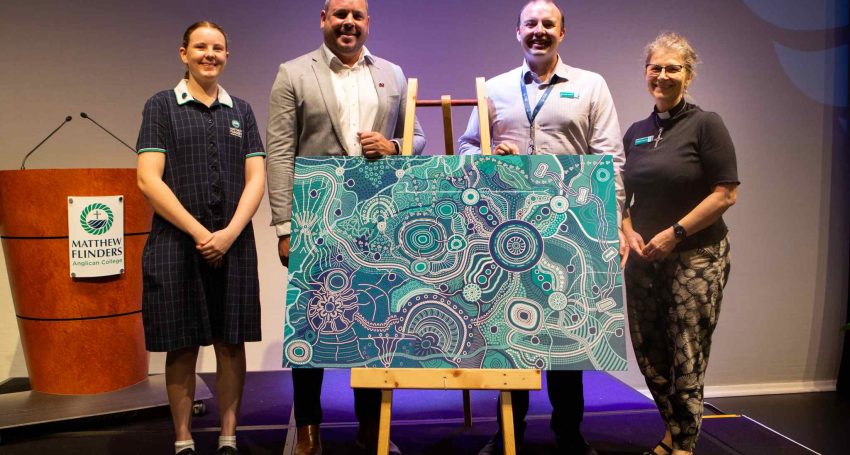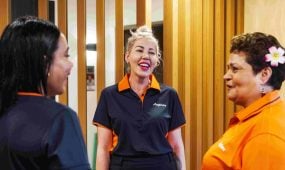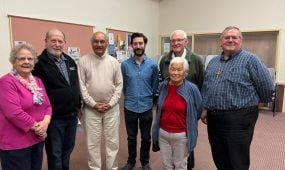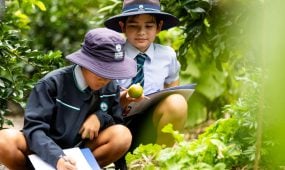
A bespoke artwork telling the story of Matthew Flinders Anglican College’s Reconciliation journey and commitment to bringing people together was recently unveiled to students, staff and special guests at a ceremony.
Titled Surrounded by our past, united by our future, the artwork was created in collaboration with students through Gilimbaa, a local Queensland creative agency driven by the power and process of storytelling in the education of culture and community.
Gilimbaa was co-founded by Executive Director David Williams, a proud Wakka Wakka man and artist, who is also an Old Flinderian.
Mr Williams said that he enjoyed facilitating the artwork workshops and exploring Reconciliation with the Flinders community last year.
“This artwork is an act of Reconciliation, and I am proud to be here today to reveal it to the College community,” Mr Williams said.
“It was a delight to work with students and staff in workshops to understand the story of how the College community is connected and also how it is embarking on this Reconciliation journey.”
David brings a lifetime of culture and connections to Gilimbaa and also drew upon his experiences attending Flinders between 1997 and 2000 in developing the artwork.
The artwork was commissioned as part of the Flinders Reconciliation Action Plan (RAP) to help strengthen relationships between Aboriginal and Torres Strait Islander communities and the College.
Captain of the Flinders Reconciliation Action Plan Group, Breanna Burnett, said that it is important for the Flinders community to learn about Aboriginal and Torres Strait Islander peoples and their cultures and histories.
Advertisement
“Seeing the effort that the school is making to show our connection and appreciation with the land, Elders and peoples…is amazing to see,” Breanna said.
“I think it is important for students to understand the history of the land we are on and build a connection and appreciation for Elders and the traditions created.
“We need to maintain a respect for First Nations peoples and learn about their customs, as well as recognise the beauty in traditional artwork and dances, the meanings behind traditional music and dances, as well as their languages.”
By actively respecting, acknowledging and recognising First Nations peoples and communities, Matthew Flinders Anglican College is united on a path towards a more reconciled Australia.
The artwork launch ceremony began with a moving Welcome to Country, which was given by traditional custodian and educator Lyndon Davis.
College chaplain The Rev’d Kathrin Koning acknowledged that the artwork was for all students and staff to engage with, as they remain open to listening and learning on the College’s Reconciliation journey.
Advertisement
David then shared a visual presentation explaining the concept and narrative behind the artwork.
During the first stage of the project, David worked with students and staff of the Flinders RAP groups as part of a four-step engagement process – explore, gather, create and connect – towards creating the final piece.
The artwork tells a story deeply connected to place – originating on Kabi Kabi / Gubbi Gubbi Country on which the school stands and flowing from the traditions and stories that have existed for countless generations.
Students were excited to hear ideas from David and to imagine how the College could respectfully use the artwork and its elements in various materials and applications.
Year 12 student Henri Everson said that the artwork powerfully connects the College community and honours thousands of years of First Nations peoples’ cultural legacy.
“The highlight was the unveiling of the artwork; more specifically, the lead up to it and how he pieced it all together whilst explaining it to the students,” Henri said.
“In doing this, David was able to convey to students the significance of this piece and how it related to them, allowing them to build a connection with the artwork.
“The incorporation of various elements that symbolise Flinders, such as animal prints, key locations and the river that winds through the artwork, is all conveyed through traditional Aboriginal art style.
“Reconciliation forms part of Australia’s national identity – this process allows Australia to acknowledge and respect the fact that people were living on the land for thousands of years before European colonists arrived.
“By commissioning this artwork, Matthew Flinders Anglican College acknowledges that before staff and students walked this land, First Nations people did.”
Special guests at the ceremony included Mununjali man Paul Paulson, Director of Indigenous Education at the Anglican Schools Commission, and Meredith Walker, a member of the Flinders Reconciliation Action Plan Group.
The artwork’s symbolism captures many College elements to explore where it has been in the past, where it is in the present, and where it wants to go in the future, including regarding:
- First Nations peoples and community
- commitment to Reconciliation
- culture
- College values of compassion, courage, integrity and respect
- growing and learning
- making connections and strengthening relationships
- pillars of Reconciliation
- inspiring our community
- kangaroo tracks.
To learn more about Reconciliation in action at Flinders, please visit the Matthew Flinders Anglican College website.





